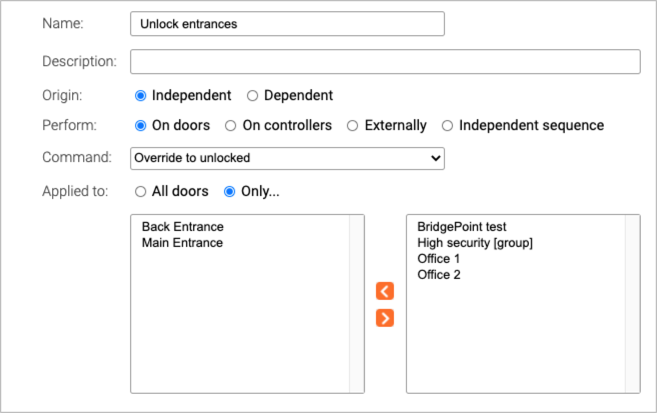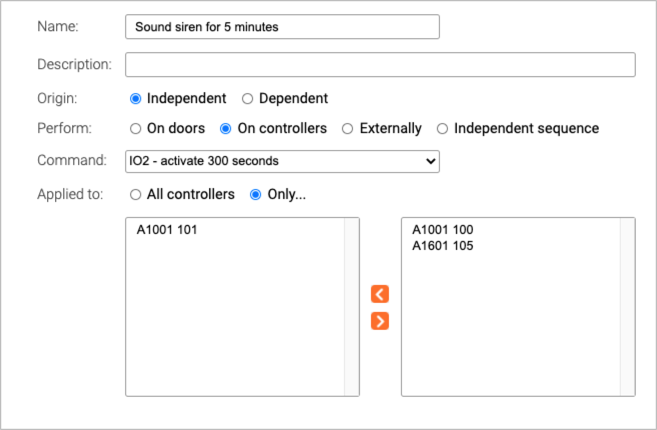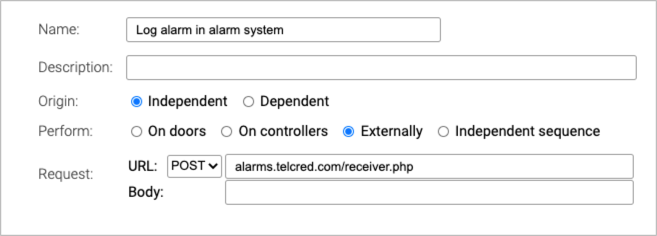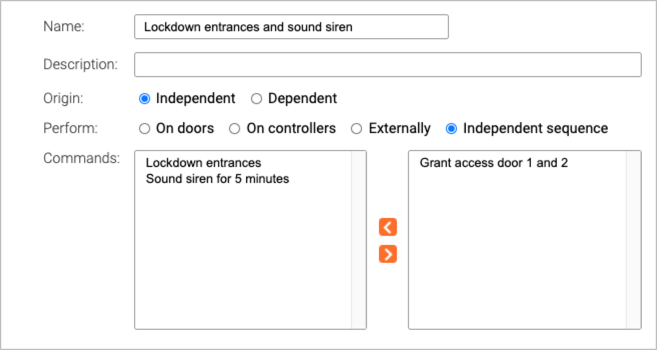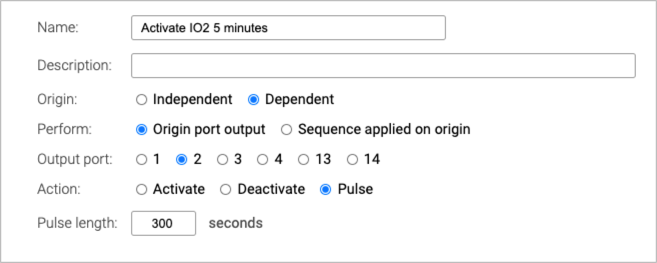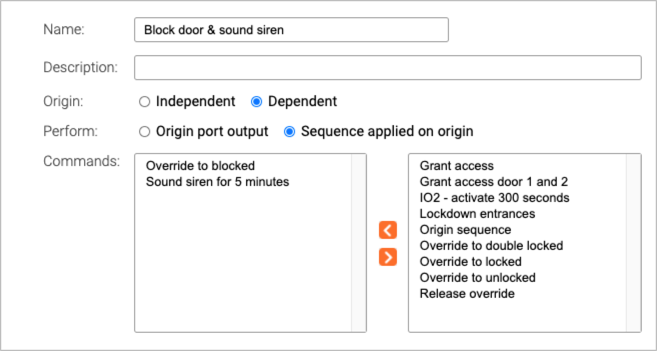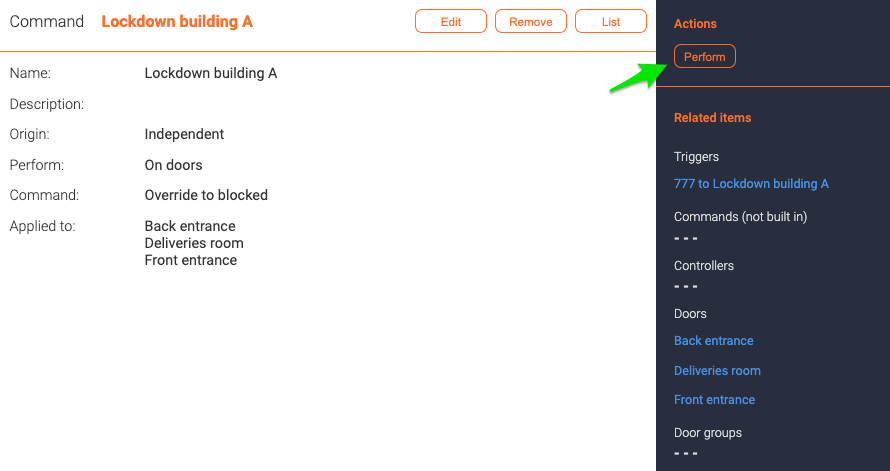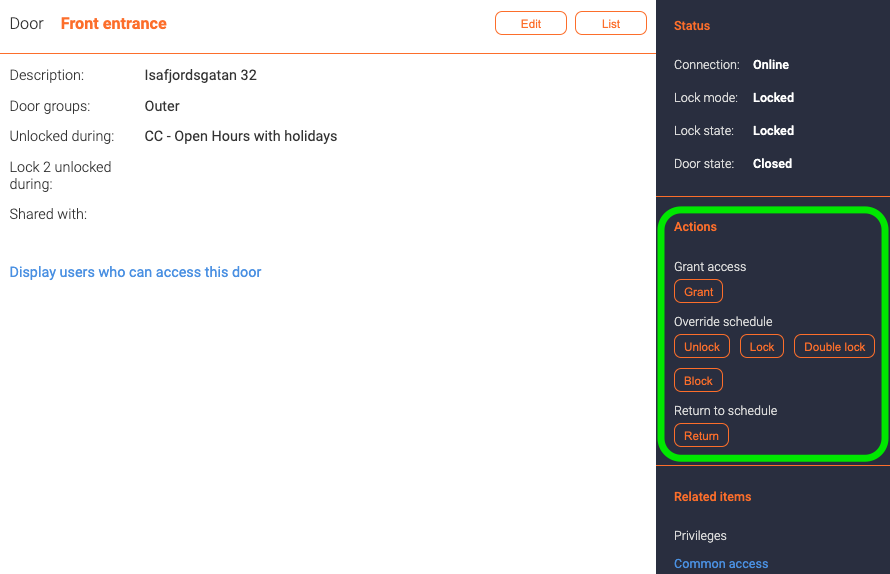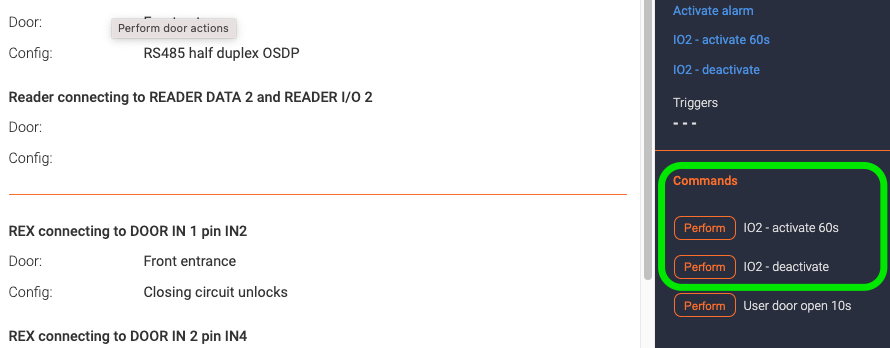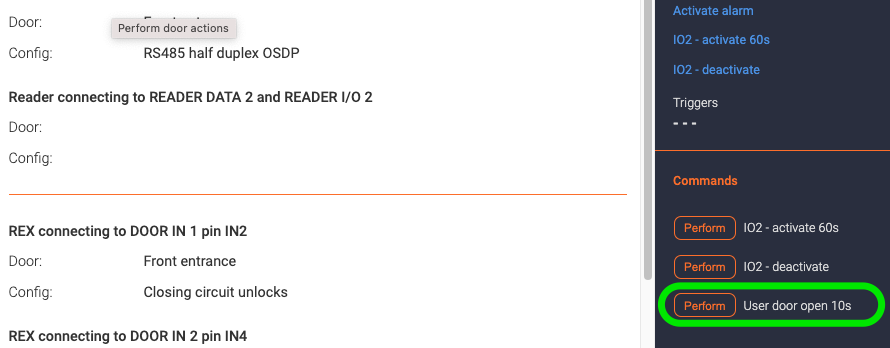Commands: Difference between revisions
Telcredstaff (talk | contribs) |
Telcredstaff (talk | contribs) |
||
| (167 intermediate revisions by the same user not shown) | |||
| Line 1: | Line 1: | ||
== Overview == |
== Overview == |
||
A ''command'' is |
A ''command'' is one or more predefined actions that can either be performed by an administrator or as a result of a [[Triggers|trigger]] being activated. |
||
Some use cases for commands include: |
|||
* Perform an action simultaneously on a set of doors, e.g. block all doors in a section of the building to achieve a "lockdown". |
|||
* Interact with an external system (e.g. arm or disarm an intrusion detection system or turn on the lights). |
|||
* Allow end users to perform an action normally only available to administrators (e.g. unlock a door or return it to schedule). |
|||
=== Origin dependency for commands and relevance for triggers === |
|||
With ''origin'' is meant a door or a controller that forms the context for executing a command. [[Triggers]] of the type 'Remote action from overview’ do not provide one, and may therefore only execute commands that are origin independent. |
|||
All other types of triggers provide an origin and may thus execute both origin independent and origin dependent commands. |
|||
Some use cases for commands and triggers include: |
|||
* Perform an action simultaneously on a number of doors, a door group, or a combination (e.g. block all doors in a section of the building to achieve a "lockdown"). |
|||
* Interact with an external system (e.g. arm or disarm an intrusion detection system) |
|||
* Allow end users to perform an action normally only available to administrators (e.g. unlock a door or return it to schedule) |
|||
== Origin independent commands == |
|||
=== Commands === |
|||
Origin independent commands always operate on the same door(s) / controller(s) / external target(s) regardless of how or from where the command is triggered. An example of an origin independent command could be to always unlock the same two doors. |
|||
When creating a new command, you need to give it a name and define which type it is: |
|||
* ''Door action''. Performs an action on one or more doors. The actions available are the same that the administrator can perform from the [[Doors|door detail page]]. |
|||
* ''External''. Will make an http request to an external system. It is possible to specify the URL, http method and body. |
|||
* ''Compound''. Includes commands already defined, which can be either ''door action'' or ''external''. This allows the administrator to create a command which both affects doors and can interact with an external system (e.g. block all doors in one building and make an http request to an alarm center). |
|||
=== Perform: On doors === |
|||
Choose the command to be executed and the door(s) to operate on. |
|||
[[File:new-command.png|New command]] |
|||
The available commands are: |
|||
* Grant access |
|||
* Override to blocked |
|||
* Override to double locked |
|||
* Override to locked |
|||
* Override to unlocked |
|||
* Release override |
|||
It is possible to perform (or "run") the command straight from its detail page: |
|||
[[File:command-independent-doors.png|Independent command on doors]] |
|||
[[File:perform-command.png|Perform command]] |
|||
If ''All doors'' is selected the command will be performed on all of the doors in the [[Delegation|organization]]. |
|||
=== Triggers === |
|||
=== Perform: On controllers === |
|||
Choose the command to be executed and the controller(s) to operate on. |
|||
Triggers are a way to start one or more commands from an access control reader. To define a trigger, it is necessary to give it a name and specify which command(s) it should start. |
|||
The available commands are the ones that have been defined for ''Origin port output'' (see the section on Origin dependent commands below). |
|||
[[File:edit-trigger.png|Edit trigger]] |
|||
[[File:command-independent-controllers.png|Independent command on controllers]] |
|||
Both user defined commands and native door actions are available. The latter will be applied only to the door where the trigger is activated. |
|||
If ''All controllers'' is selected the command will be performed on all of the controllers in the [[Delegation|organization]]. |
|||
=== Perform: Externally === |
|||
The next step is to define how to activate the trigger. Trigger PIN codes always start with a * followed by one or more digits. It is recommended to use the same number of digits as for normal user PIN codes. |
|||
Construct the API call to be performed by choosing the http method (GET/PUT/POST) and the body of the message. |
|||
[[file:trigger-settings.png|Trigger settings]] |
|||
[[File:command-independent-externally.png|Independent command externally]] |
|||
If no credential is specified, anyone can activate the trigger. To avoid this, specify an authentication credential (card or PIN) and which role(s) that should have access to the trigger. Note that in this context, the PIN is the user's PIN, which has nothing to do with the trigger PIN. |
|||
=== Perform: Independent sequence === |
|||
A list of origin independent commands to be executed in a given order. Note that if one command fails, the sequence will be terminated. |
|||
[[file:trigger-authentication.png|Trigger authentication]] |
|||
[[File:command-independent-sequence.png|Independent command sequence]] |
|||
Finally, it is possible to define restrictions on the trigger: |
|||
* When it can be entered (schedule) |
|||
* On which doors it can be entered (doors and/or door groups) |
|||
== Origin dependent commands == |
|||
For origin dependent commands, it matters ''from where'' the command is triggered. The door or controller on which the command operates is dependent on the ''origin'' of the trigger. |
|||
[[file:trigger-restrictions.png|Trigger restrictions]] |
|||
One example of an origin dependent command is to unlock a door by entering a special code on its associated reader. |
|||
==== Using a trigger on a reader ==== |
|||
An origin is either a door or a controller. Given a door origin, a command that requires a controller, when executed, will be applied on the controller of the door. Given a controller origin, a command that requires a door, when executed, will be applied on each of the doors of the controller. |
|||
As all readers behave a bit differently, there is not one way to describe exactly what using a trigger on any particular reader will look like. However, the general process will look like this: |
|||
=== Perform: Native door command === |
|||
===== No authentication credential required ===== |
|||
Door commands are "native", i.e. are already available in the system, so there is no need to define them before they can be invoked by a trigger or included in other commands. |
|||
# Enter the trigger PIN (e.g. *111). |
|||
# Wait for a blinking "success indicator" (will blink for approx two seconds). The success indicator indicates that the command completed successfully, and will look different on different readers. If the success indicator is not displayed, the command failed to complete all of its actions. |
|||
The native door commands are: |
|||
===== Authentication credential required ===== |
|||
* Grant access |
|||
* Override to blocked |
|||
* Override to double locked |
|||
* Override to locked |
|||
* Override to unlocked |
|||
* Release override |
|||
=== Perform: Origin port output === |
|||
# Enter the trigger PIN (e.g. *111). |
|||
# Wait for the reader to start blinking (can take a few seconds). This means that the reader has been temporarily blocked and is ready to receive the authentication credential (i.e. card or personal PIN) without granting access. |
|||
Select the target output port and the action that should be performed. |
|||
# Wait for a blinking "success indicator" (will blink for approx two seconds). The success indicator indicates that the command completed successfully, and will look different on different readers. If the success indicator is not displayed, the command failed to complete all of its actions. |
|||
Note that not all controllers have all IO ports (e.g. Axis A1001 only has IO1 and IO2) so it is necessary to know which type of controller that will be used when specifying the output port of the command. It is also necessary to [[A1001_settings#IO_port_settings|configure the IO ports of the controller]]. |
|||
The available actions are: |
|||
* Activate |
|||
* Deactivate |
|||
* Pulse |
|||
For Pulse, it is possible to set the pulse length in seconds. |
|||
[[File:command-dependent-port.png|Dependent command port output]] |
|||
=== Perform: Sequence applied on origin === |
|||
A list of commands of any type to be executed in a given order. The origin will be used for any origin dependent commands in the list. |
|||
[[File:command-dependent-sequence.png|Dependent command sequence]] |
|||
Note that if one command fails, the sequence will be terminated. |
|||
== Performing commands from the administrator GUI == |
|||
=== Origin independent commands === |
|||
Origin independent commands can be performed from their detail page: |
|||
[[File:perform-command-independent.png|border|Perform independent command]] |
|||
=== Native door commands === |
|||
Native door commands can be performed from a door detail page, where they are called ''Actions''. |
|||
[[File:perform-door-actions.png|border|Perform door actions]] |
|||
=== Origin port commands === |
|||
Origin port output commands can be performed from a controller detail page (if the controller has a matching output port configured). |
|||
[[File:perform-origin-port-commands.png|border|Perform origin port commands]] |
|||
=== Sequence applied on origin === |
|||
A sequence of commands of which at least one is origin dependent can be launched from either a door detail page or a controller detail page. |
|||
[[File:perform-sequence-on-origin.png|border|Perform sequence applied on origin commands]] |
|||
Given a door origin, a command that requires a controller, when executed, will be applied on the controller of the door. Given a controller origin, a command that requires a door, when executed, will be applied on each of the doors of the controller. |
|||
Latest revision as of 16:41, 13 October 2021
Overview
A command is one or more predefined actions that can either be performed by an administrator or as a result of a trigger being activated.
Some use cases for commands include:
- Perform an action simultaneously on a set of doors, e.g. block all doors in a section of the building to achieve a "lockdown".
- Interact with an external system (e.g. arm or disarm an intrusion detection system or turn on the lights).
- Allow end users to perform an action normally only available to administrators (e.g. unlock a door or return it to schedule).
Origin dependency for commands and relevance for triggers
With origin is meant a door or a controller that forms the context for executing a command. Triggers of the type 'Remote action from overview’ do not provide one, and may therefore only execute commands that are origin independent.
All other types of triggers provide an origin and may thus execute both origin independent and origin dependent commands.
Origin independent commands
Origin independent commands always operate on the same door(s) / controller(s) / external target(s) regardless of how or from where the command is triggered. An example of an origin independent command could be to always unlock the same two doors.
Perform: On doors
Choose the command to be executed and the door(s) to operate on.
The available commands are:
- Grant access
- Override to blocked
- Override to double locked
- Override to locked
- Override to unlocked
- Release override
If All doors is selected the command will be performed on all of the doors in the organization.
Perform: On controllers
Choose the command to be executed and the controller(s) to operate on.
The available commands are the ones that have been defined for Origin port output (see the section on Origin dependent commands below).
If All controllers is selected the command will be performed on all of the controllers in the organization.
Perform: Externally
Construct the API call to be performed by choosing the http method (GET/PUT/POST) and the body of the message.
Perform: Independent sequence
A list of origin independent commands to be executed in a given order. Note that if one command fails, the sequence will be terminated.
Origin dependent commands
For origin dependent commands, it matters from where the command is triggered. The door or controller on which the command operates is dependent on the origin of the trigger.
One example of an origin dependent command is to unlock a door by entering a special code on its associated reader.
An origin is either a door or a controller. Given a door origin, a command that requires a controller, when executed, will be applied on the controller of the door. Given a controller origin, a command that requires a door, when executed, will be applied on each of the doors of the controller.
Perform: Native door command
Door commands are "native", i.e. are already available in the system, so there is no need to define them before they can be invoked by a trigger or included in other commands.
The native door commands are:
- Grant access
- Override to blocked
- Override to double locked
- Override to locked
- Override to unlocked
- Release override
Perform: Origin port output
Select the target output port and the action that should be performed.
Note that not all controllers have all IO ports (e.g. Axis A1001 only has IO1 and IO2) so it is necessary to know which type of controller that will be used when specifying the output port of the command. It is also necessary to configure the IO ports of the controller.
The available actions are:
- Activate
- Deactivate
- Pulse
For Pulse, it is possible to set the pulse length in seconds.
Perform: Sequence applied on origin
A list of commands of any type to be executed in a given order. The origin will be used for any origin dependent commands in the list.
Note that if one command fails, the sequence will be terminated.
Performing commands from the administrator GUI
Origin independent commands
Origin independent commands can be performed from their detail page:
Native door commands
Native door commands can be performed from a door detail page, where they are called Actions.
Origin port commands
Origin port output commands can be performed from a controller detail page (if the controller has a matching output port configured).
Sequence applied on origin
A sequence of commands of which at least one is origin dependent can be launched from either a door detail page or a controller detail page.
Given a door origin, a command that requires a controller, when executed, will be applied on the controller of the door. Given a controller origin, a command that requires a door, when executed, will be applied on each of the doors of the controller.
